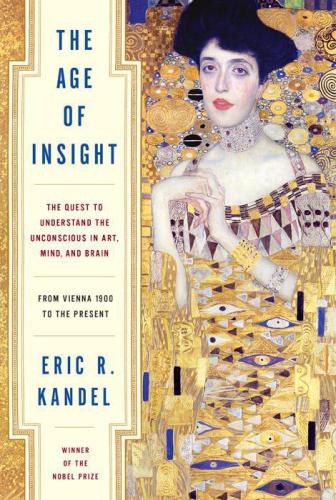
The Age of Insight
The Quest to Understand the Unconscious in Art, Mind, and Brain, from Vienna 1900 to the Present
کتاب های مرتبط
- اطلاعات
- نقد و بررسی
- دیدگاه کاربران
نقد و بررسی

February 20, 2012
In this engrossing if overstuffed treatise, Nobel-winning neuroscientist Kandel (In Search of Memory: The Emergence of a New Science of Mind) excavates the hidden workings of the creative mind. He starts with the art of Viennese Modernist painters Gustav Klimt, Oskar Kokoschka, and Egon Schiele, linking their distorted imagery, intense evocations of neurotic emotion, and frank erotic themes to Freud’s contemporaneous theorizing on the unconscious mind and repressed sexuality. From there Kandel leaps to the hard science of how unconscious neural mechanisms underlying everything from visual perception to emotional impulses determine conscious aesthetic reactions. (It’s the varying acuities of the retina’s cone cells, he contends, that make the Mona Lisa’s smile so enigmatic.) Kandel writes perceptively about a range of topics, from art history—the book’s color reproductions alone make it a great browse—to dyslexia. Inevitably, his brush-strokes-to-brain waves ambition to integrate so many subjects feels a ill-chewed; it’s either too dense or too sketchy, and too quick to assimilate Freudian-modernist notions of the unconscious to scientific concepts. Still, Kandel captures the reader’s imagination with intriguing historical syntheses and fascinating scientific insights into how we see—and feel—the world.

Starred review from January 1, 2012
In a polymathic performance, a Nobel laureate weaves together the theories and practices of neuroscience, art and psychology to show how our creative brains perceive and engage art--and are consequently moved by it. Kandel (Biochemistry and Biophysics/Columbia Univ. College of Physicians; In Search of Memory, 2006, etc.) is uniquely equipped for this vast task. Born in Vienna, a collector of Klimt and Kokoschka, a scientist of the first rank, the author possesses in abundance the myriad requirements for such an integrative enterprise. Moving seamlessly and effortlessly between the worlds of art and science, Kandel begins with a look at the art world of Vienna, 1900. Then it's off to Freud, whose theories and discoveries the author treats with great respect, awarding credit where it's due, noting but not condemning errors. Kandel also glances at innovations in literature, especially the technique of interior monologue pioneered by Arthur Schnitzler in his Lieutenant Gustl (1900). Some sexy chapters ensue as Kandel discusses sexuality in art, and sex remains a leitmotif. He looks at how painters reveal the interior states of their subjects, and he examines the theories and discoveries of neuroscientists--though he continually returns to the art world for illustration, elaboration and example. Kandel reminds us that the brain creates the world for us: Our poor eyes bring in only a fraction of what's there; the brain assembles and interprets, using memory as a principal guide. Readers will also learn how artists can make a subject's eyes seem to follow the viewer, how scientists have used animals and imaging to explore the brain and how artists employ models' faces, hands and attitude to affect us, to prompt our empathy. Kandel also investigates the nature of creativity. A transformative work that joins the hands of Art and Science and makes them acknowledge their close kinship.
(COPYRIGHT (2012) KIRKUS REVIEWS/NIELSEN BUSINESS MEDIA, INC. ALL RIGHTS RESERVED.)

October 1, 2011
Kandel won the Nobel Prize in Medicine in 2000 and a Los Angeles Times Book Award in 2006 for In Search of Memory. All of which suggests that this study of how we came to recognize the unconscious will make great reading. Kandel starts in 1900 Vienna and focuses on five individuals--Sigmund Freud, Arthur Schnitzler, Gustav Klimt, Oskar Kokoschka, and Egon Schiele--whose work laid the foundations for today's brain science. Science and art as partners--I love it! For your smart readers.
Copyright 2011 Library Journal, LLC Used with permission.

March 1, 2012
Inspired by his interest in expressionist artists Gustav Klimt, Oskar Kokoschka, and Egon Schiele, Kandel subjects their oeuvres to intensive analysis that integrates Freudian and Gestalt psychology, art history, and neuroscience. A Nobel laureate for his scientific research, covered in his memoir In Search of Memory (2006), Kandel sets several aims for his discussion. The radical direction taken by the expressionists induces Kandel's consideration of their immediate influences, be they fascination with Freud's theories (by Klimt, especially), the emotional tides of their personal lives, or painting's general drift from realism. This trio certainly accelerated the last, and the human emotions evoked by their portraits and nudes, dozens of which the book reproduces, attract Kandel's discerning observations. Art historians Ernst Kris and Ernst Gombrich, who later critiqued the revolution Klimt, Kokoschka, and Schiele wrought, help Kandel link his application of scientific studies of visual perception and the viewer's experience of the expressionists and art in general. Can science and art appreciators coexist for Kandel's prime readers? Yes, if they are not casual readers and are ready for his involved explorations of their interests.(Reprinted with permission of Booklist, copyright 2012, American Library Association.)

























دیدگاه کاربران